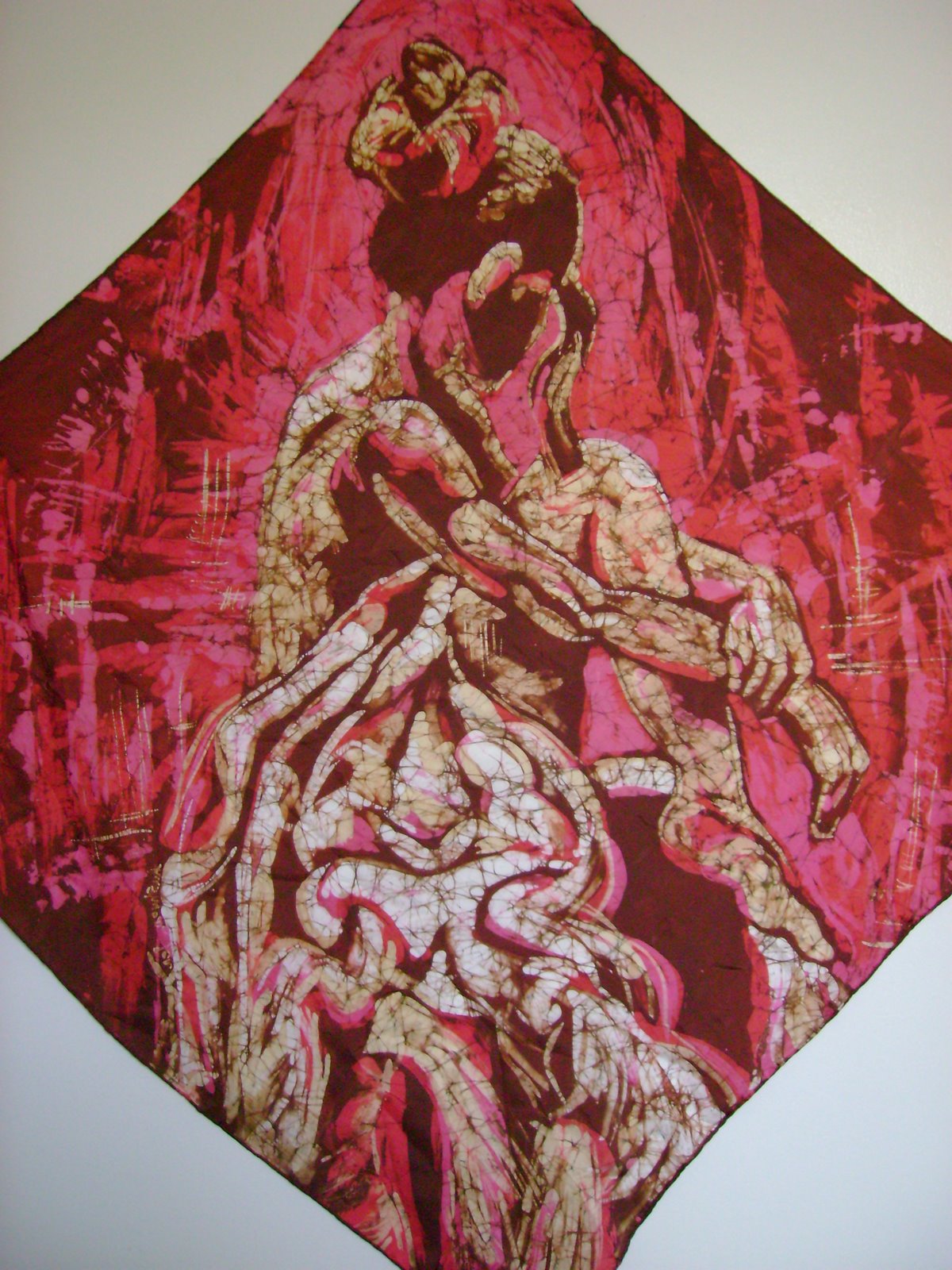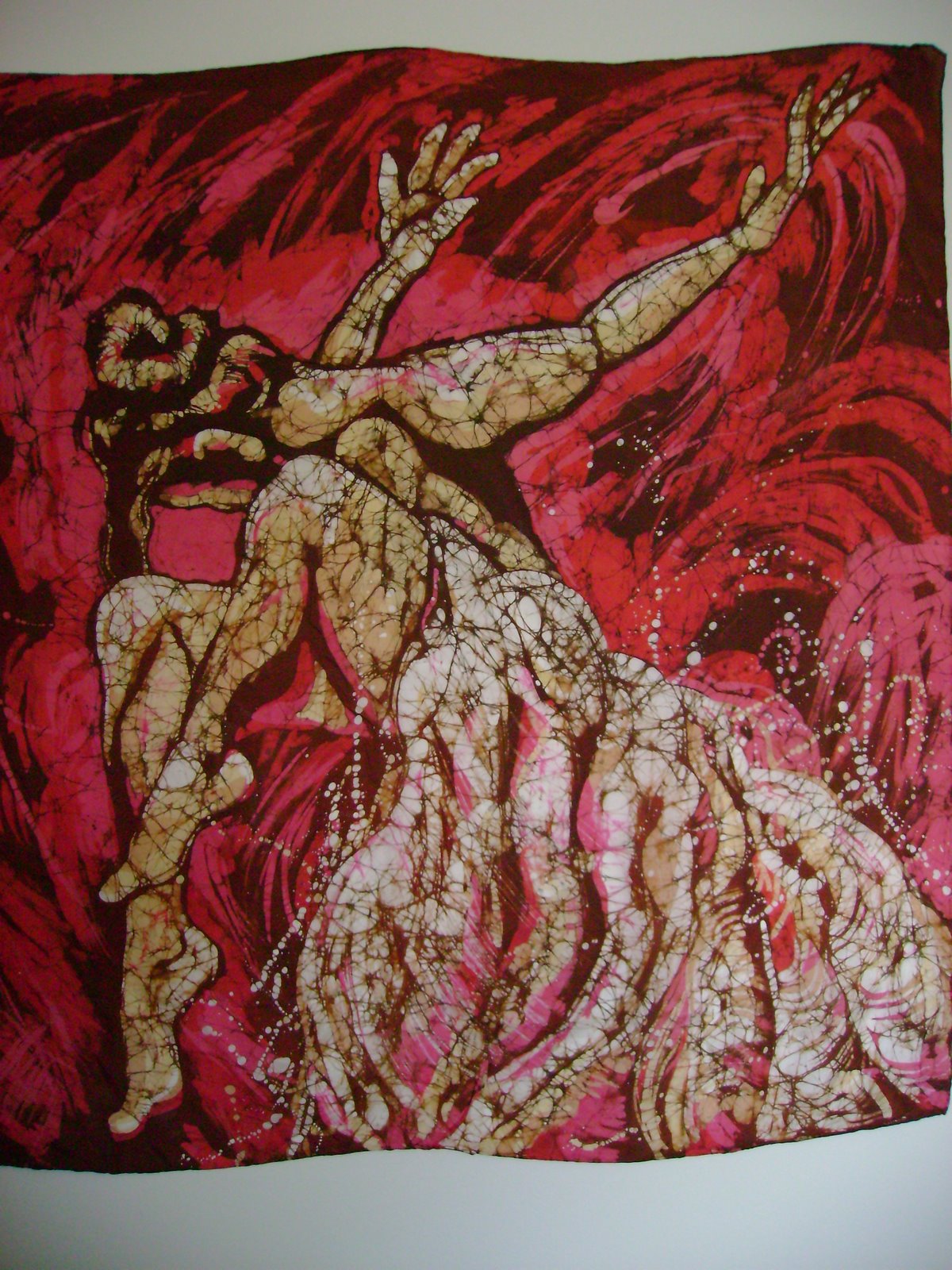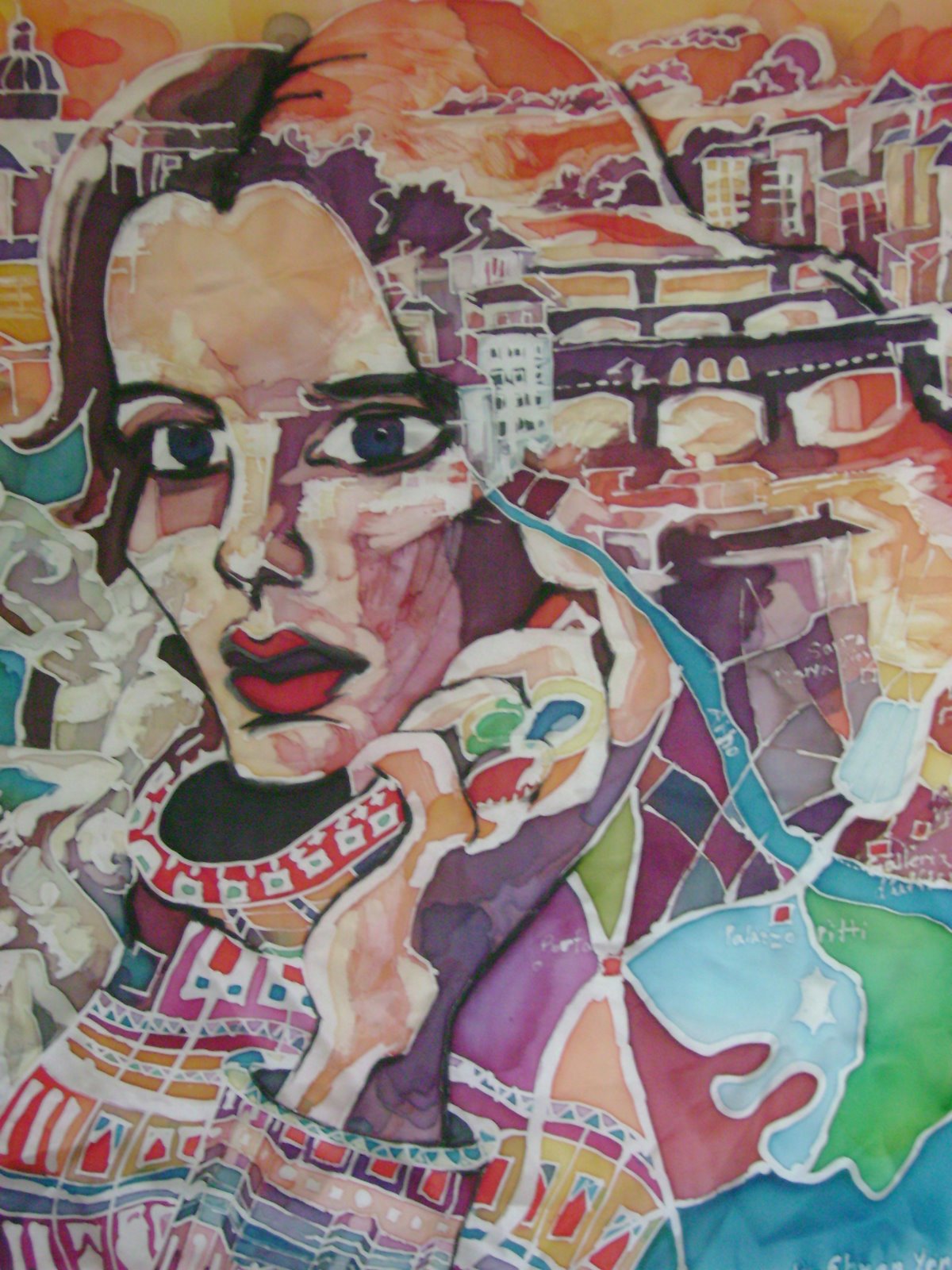View by Country and Subject
- America (3)
- Batik and I (4)
- Batik background (1)
- China (1)
- Ghana (4)
- Indonesia (7)
- Japan (26)
- Malaysia (11)
- Mali (6)
- Quarterly Reports (4)
- Senegal (1)
- sketchbook (1)
- Thailand (5)
- The Gambia (8)
- the journey of art (1)
- The Watson Fellowship (3)
- United Kingdom (22)
Saturday, September 13, 2008
Batik in Thailand: a Tourist Commodity
As Published in myBatik Magazine
Although batiks did not originate in Thailand, they have adapted to the lush and colorful landscape of this country. Here, artists have created batik designs and products that are sold around the world as “traditional” Thai products. Such designs usually reference the sun, surf, animals and vegetation of Thailand—making them perfect souvenirs for the multitude of visitors who flock to the country every year. As a substantial part of the tourist market, these textiles have become an important source of income for many villagers. For the most part, the batiks created in Thailand are not sold to the locals, but to the multitude of visitors who come through or else shipped to foreigners abroad. Not only has tourism affected batik as an industry, but it has altered the look, feel, function and creation of this ancient craft.
Travelers to Thailand want to buy what the locals buy and batiks are ubiquitous throughout the country. There is a difference however between “tourist” batiks and the batiks that are worn by the natives. Locals want to purchase batiks imported from China or Indonesia while tourists gravitate exclusively toward batiks that were made in Thailand. Small batik stalls in indigenous markets sell Chinese or Indonesian batiks while large, modern batik shops located in more touristy areas sell items that are handmade, one-of-a-kind and uniquely Thai. Whereas locals would consider any imperfection to be a major flaw, they are pointed out to the tourist as a sign of authenticity.
Tourist batiks are clearly set apart by their vibrant colors and deep-sea, tropical fish, seashell, vegetable and fruit motifs. They are a reflection of Thailand and a memento for visitors to remember their vacation. Not so clear-cut is the difference in how a batik is used. An attractive sarong may be used by a Thai as casual-wear for relaxation in the home while a Western customer may consider it perfectly acceptable to wear to a fancy dinner party. Many beach outfits, form-fitting clothing or garments that expose a lot of skin would never be worn by a local and are created solely for the Western tourist.
Unlike the dotted wax designs of Indonesia which use predominantly yellow, brown and red, batiks in Southern Thailand are made of solid lines between which the segments are filled in with colorful dyes. Three to five colors are often used together and blended with the fingers or tissues to create tone, resulting in brilliantly colored clothing and accessories. Since the wax used in Thailand contains very little of the brittle paraffin wax that create the characteristic batik crackle, the designs here are clear and un-veined.
Northern Thailand has their own unique form of batik. Here they are often made of hemp and dyed solely with indigo. These villagers make, gather, spin, and weave hemp to create traditional H’mong batik. Created in lengths of 5 – 8 yards, they are later steamed, starched and pleated to make the traditional H’mong women’s skirts. Extensive appliqué and embroidery is then added, enhancing the batik design underneath. Even though these batiks are “traditional,” they have ceased to become the main attire for these villagers and it is the tourist industry that now drives their production.
While batik cloth are often used by both men and women as sarongs or wraps, their function has expanded with tourism. Bright batik cloth can now be seen in the form of sarongs, shirts, ties, scarves and even shoes in the fashion industry. For interior decoration there are batik tablecloths, curtains, placemats and even picture frames.
Not only is this versatile and durable textile being applied to more areas, but the process of making batik is becoming a popular attraction for many visitors to Thailand. Batik lessons are used as a way to make money from the tourist groups who arrive to experience village life and Thailand “crafts” firsthand. Many shops or villages provide batik classes for tour groups, which begin with tracing a design on to a stretched handkerchief with a soft lead pencil that will wash out. Assisted by staff, wax is applied, then the paint. The fixing and wax removal is later carried out by assistants before the tourists are allowed to take their masterpiece home as souvenirs.
In Indonesia, batik cloth was used to make costumes for aristocrats and royalty; sometimes, particular designs would signify a person’s family, social status or origin. Although there are no specific designs that demarcate the Thai Royal family, they are often seen in public wearing batiked attire. Furthermore, Surichai Gansongsang, who is considered one of Phuket's most skilled batik artists has estimated that 80 percent of the local government authorities in Phuket wear uniforms with batik shirts. Multi-award winning Khun Surichai was even asked to create the design for the outfits that the Thai and Foreign delegates wore to the Asia-Pacific Economic Cooperation (APEC) meeting in Phuket.
The Thai government under the patronage of the Royal family and Queen Sirikit in particular, are very supportive of all kinds of traditional craft skills such as batik and have set up OTOP (one tambon, one craft) which has shops throughout Thailand and abroad. Designed by Thai Prime Minister Thaksin Shinawatra during the 2001-2006 Thai Rak Thai government, the program aims to support the unique locally made and marketed products of each Thai tambon (subdistrict). There are now 36,000 OTOP groups across the country, each with 30 to 3,000 people per group. Sakda Siridechakul, president of Chiang Mai's OTOP association noted that, "OTOP has helped incomes to be spread to many people in the villages. It has given people producing handicrafts to feel they can be part of the global economy."
It is obvious that batiks have become an important part of Thailand, both culturally and economically. There is a drastic difference however between Thai batik and Batik in Thailand. The first is a product of Thailand, the second is sold in Thailand. Thai batik has expanded with the growth of tourism and is now an essential source of income for many artists here. The bright colors and lively designs of these “tourist” batiks are representative of this land of plenty, providing visitors with a memento of Thailand even if the fabric itself is not representative of batik in Thailand.
Tuesday, August 19, 2008
Do good fences make good neighbors?

Visa problems and border issues have made me think of and question the line “good fences make good neighbors” from Robert Frost’s “Mending Wall” in which one man questions why he and his neighbor must rebuild the stone wall dividing their farms each spring:
“My apple trees will never get across
And eat the cones under his pines, I tell him.
He only says, 'Good fences make good neighbors'.
Spring is the mischief in me, and I wonder
If I could put a notion in his head:
'Why do they make good neighbors?
Isn't it where there are cows?
But here there are no cows.
Before I built a wall I'd ask to know
What I was walling in or walling out,
And to whom I was like to give offence.”
It is amazing to me that the barriers between languages, culture, race and gender that I have encountered during my travels have been nothing compared to that created by politics and money.
Visa and border regulations have been the most confusing, exasperating and problematic part of my Watson journey so far. Although I feel American, my Taiwanese passport states otherwise and in terms of traveling, it means the difference between complete freedom and infuriating constraints.

Thus, I have realized that there are actually two parts to my Watson Fellowship.
Batik: Paths of Molten Wax on Volatile Cloth; a Journey of Transformation.
AND
Visas: Doors of Solid Steel Between Volatile Borders; a Journey of Displacement
As I trace the path of batik around the world, I will inevitably learn more about the political and economical ties between countries. Their relationship to Taiwan will determine the course of my travels.
I want desperately to believe in a peaceful and harmonious world without borders but how can it can be possible when it is human nature to put up walls between ourselves? Why are some people so open and accepting of different people and ideas while others close themselves against them?
These are questions that I will explore during my Watson journey whether I want to or not. Perhaps by the end of 12 months, I will at least be one step closer to the answer.
Tuesday, August 12, 2008
Sun, surf, batik

If not the roosters, then the howling wind and pouring rain is what wakes me up before dawn every morning here in the tiny village of Ban Talae Nok in southern Thailand. Ban means village, talae is sea and nok describes something at a distance. This “faraway village of the sea,” perched on the Andaman Sea marks the launching point of my batik journey and it is my second week here.
After a breakfast of sweet glutinous rice in banana leaf, sugary coffee and syrupy fried dough (thank God for the fruit) I make my way to the home of batik artist Ga Dei, where I will spend the next 9 hours applying wax and paint to cloth, with a hour break for lunch. It amazes me how quickly an entire day passes when I am absorbed in a single task. Before I know it, Ga Dei is pointing at the clock and I barely have time to run to the beach for a quick swim before dinner, followed by sketching for the next day’s work and an early bedtime.
 Although it feels as if I have been traveling forever, my actual Watson journey only started two weeks ago and I am still adjusting to the fact that I am now completely on my own. With no English speakers within miles (the first westerner to visit the village arrived just three years ago) I have lived inside my own head for the past 14 days. Gradually, I am starting to listen to myself and accept that there is no one around to admire or condemn my bouts of inspiration. Lonely at first, I now find that I am able to think more slowly and look more closely at the world around me when there is no pressure to maintain a conversation. Every day I open my eyes to new things and am amazed at the infinite variety of colors, shapes and patterns that appear. Somehow my own creativity drives me more than grades or teachers ever have and I feel the need to simply produce as quickly as I can, before the vision escapes me.
Although it feels as if I have been traveling forever, my actual Watson journey only started two weeks ago and I am still adjusting to the fact that I am now completely on my own. With no English speakers within miles (the first westerner to visit the village arrived just three years ago) I have lived inside my own head for the past 14 days. Gradually, I am starting to listen to myself and accept that there is no one around to admire or condemn my bouts of inspiration. Lonely at first, I now find that I am able to think more slowly and look more closely at the world around me when there is no pressure to maintain a conversation. Every day I open my eyes to new things and am amazed at the infinite variety of colors, shapes and patterns that appear. Somehow my own creativity drives me more than grades or teachers ever have and I feel the need to simply produce as quickly as I can, before the vision escapes me.Artist’s block was and still is my greatest fear for this journey and this flood of inspiration is a relief. The problem so far has been in choosing between all of the ideas I have and I cannot wait to make them all a reality.
 The stare of the blank white canvass they planted in front of me on my first day here was not at all inspiring however and the crowd of villagers who had come to see the falong (foreigner) only increased the pressure. With 15 staring eyes, expecting me to perform, I put wax to cloth and drew the first thing that come into view – the smile of most adorable little girl I have ever seen. Experience has shown me that drawing a child can win anyone over and this crowd was no exception. Since then, I have already created 9 batiks in 12 days – not bad for a girl who took 4 months to just to start her senior batik project.
The stare of the blank white canvass they planted in front of me on my first day here was not at all inspiring however and the crowd of villagers who had come to see the falong (foreigner) only increased the pressure. With 15 staring eyes, expecting me to perform, I put wax to cloth and drew the first thing that come into view – the smile of most adorable little girl I have ever seen. Experience has shown me that drawing a child can win anyone over and this crowd was no exception. Since then, I have already created 9 batiks in 12 days – not bad for a girl who took 4 months to just to start her senior batik project.

Eat, sleep, batik. What else is there? Hooray for the Watson!

Wednesday, June 18, 2008
Elephants, hills tribes and fish sauce, oh my!

 Although a Watson scholarship covers twelve months of travel, I decided to start two months early, in the name of pure unhindered fun with my friends before the real batik project starts. With this initial goal in mind, I stepped onto the plane headed for Thailand and thus began my 14-month adventure around the world.
Although a Watson scholarship covers twelve months of travel, I decided to start two months early, in the name of pure unhindered fun with my friends before the real batik project starts. With this initial goal in mind, I stepped onto the plane headed for Thailand and thus began my 14-month adventure around the world. 
In any case, I followed the yellow-tiled path out the door of the airport and into the welcoming arms of four friends from the U.S. who will join me for the first month of my journey. Before they even had time to respond to my fervent burst of hello, I promptly whisked them away to meet my seatmate (on the flight from Bankok) and new friend Yee—a 21 year-old Chinese-Thai girl studying in Oklahoma U.S.A! She led us to a teashop inside the airport for an impromptu party and some delicious refreshments. Little did we know that the shop belonged to her family who actually grew the tea we were drinking and own one of the largest tea farms in Doi Mae Salong—a town on the northernmost tip of Thailand famous for their tea and populated with Chinese immigrants.
 Of course we took advantage of Yee’s generous invitation to her home and were treated like royalty during our two day stay there. Upon arrival, she immediately charted us off to a museum that detailed the history the Chinese in Thailand. It was eye-opening to realize that Taiwan was not the only place the Nationals fled to after the Cultural Revolution and that Thailand was actually an option closer to home. With over 8.5 million Chinese immigrants, Thailand has more overseas Chinese than any other country in the world! Just when I thought that I leapt completely into the unknown, I find that I am actually closer to home than I could have imagined. It is amazing how similar my fate is to Yee’s and I wonder what sort of person I would have become if my grandparents had ended up here in Thailand instead of Taiwan? As I drank in the amazing scenery and the even more aromatic tea, I daydreamed about what my life could have been like in this beautiful land of plenty.
Of course we took advantage of Yee’s generous invitation to her home and were treated like royalty during our two day stay there. Upon arrival, she immediately charted us off to a museum that detailed the history the Chinese in Thailand. It was eye-opening to realize that Taiwan was not the only place the Nationals fled to after the Cultural Revolution and that Thailand was actually an option closer to home. With over 8.5 million Chinese immigrants, Thailand has more overseas Chinese than any other country in the world! Just when I thought that I leapt completely into the unknown, I find that I am actually closer to home than I could have imagined. It is amazing how similar my fate is to Yee’s and I wonder what sort of person I would have become if my grandparents had ended up here in Thailand instead of Taiwan? As I drank in the amazing scenery and the even more aromatic tea, I daydreamed about what my life could have been like in this beautiful land of plenty.














